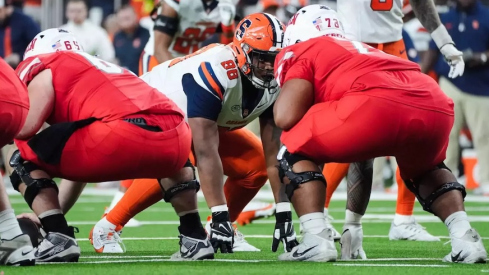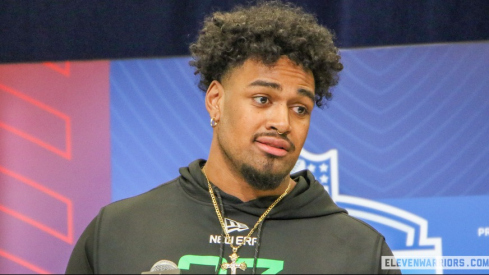
The Ohio State defense put together another positive performance in its near shutdown of Illinois. The Buckeye defense is on an upward trajectory based upon the same contributing factors—the return to health of key contributors, different personnel grouping, and slight tweaks in schemes—that continue to build upon each other in a virtuous cycle. While the Buckeye defense will be more tested in coming weeks, there is reason to believe that the Buckeye defense has improved in the second half of the season.
Stick to the Script
Illinois sought several 'wrinkles' to create some type of offense. Primarily, the Illini used an extensive amount of direct quarterback lead runs with Nathan Scheelhaase. The Illini were clearly looking for some way to create an arithmetic advantage against the OSU base nickel defense.
Illinois also frequently used rocket motion with their running back to the flat. The idea was to stretch OSU's zone defense to create opportunities inside those defenders, just as Indiana found some success with.
OSU did not get fancy in response. Instead, after continually tinkering this year, the Buckeye coaching staff has seemingly settled with what has become their basic framework—cover 4 on first down against 11 personnel, with ample amounts of cover 1 on second and third down, mixed with cover 2 and 3 in must-pass situations.
The Buckeyes also like to mix in zone blitzes in medium downs, with man blitzes on third and long.
This also seemed to reflect Illinois' personnel groupings. The Buckeyes seemingly liked to use cover 4 against Illinois' shotgun spread '11' personnel, going to the other coverages more frequently versus Illini '10' packages (4 WR, 1 RB, 0 TE). By contrast, against Penn State, the Buckeyes used a lot of cover 1 versus its pro-style '21' groupings (2 WR, 1 RB, 1 TE).
Searching for Something
But the continued use of cover 4 belies an important point—the Buckeye coaching staff has made a critical change, namely to the defense's force player (H/T to my defensive coaching friend 'Dvo45' for pointing this out). Again, the basic building block of any defense is a determination as to how you will corral ball carriers to an area where most of your defenders are amassed. To do so, defenses use a 'force' player to maintain outside leverage to literally force the ball carrier inside, a leverage or alley player to fill outside in, and then backside pursuit scraping in to out. Every defense does this, though different positions can have these responsibilities, determined primarily by what coverage a defense is in.
As previously discussed, cover 4 uses the two safeties as force support, where they must quickly come up on run action to force the running back inside. This was something the OSU safeties struggled with earlier this year. The Buckeye defensive coaching staff thus seems to have altered run support responsibilities within cover 4. To the field in nickel, OSU is now using its star as its force support, with the safety then coming inside to be the alley player. Note how Orhian Johnson maintains outside leverage, forcing the running back back inside and right to where CJ Barnett is filling the resulting alley.
To the boundary, the weakside end is fulfilling this responsibility, allowing Ryan Shazier to scrape down to make the tackle.
In other words, Buckeye coaching staff has altered its responsibilities so that the same position players are responsible for force contain as they were under Jim Heacock. This seems to fit the Buckeye personnel better and is something they are more comfortable with, while allowing OSU to still play more 'man' coverages.
It's All About the Jimmy and Joes
The biggest adaptation, however, is simply having key players return to health and/or step up within these rules. CJ Barnett is a perfect example. He was slowed early in the year with a sprained ankle. He now looks healthy, however, and is doing a far superior job attacking the run game downhill from the alley. His health also allows the Buckeyes to play cover 1. Barnett is able to cover the field slot receiver, with Christian Bryant at deep safety. Shazier is another defender whose improvement cannot be overstated. Whereas he once continually overran plays and took poor angles, Shazier is now playing under control inside-out, as demonstrated above. His tackling is also much improved. He and Zach Boren have thus revived a struggling linebacker corps through nothing more than at least taking fundamentally sound pursuit angles.
Another such example is Nate Williams. To me, Williams is the defense's MVP, a huge leap from a player who some thought would be unable to return from microfracture surgery. But one need only look to the Indiana game he missed to see his value. Williams' impact is primarily felt through his versatility—he plays like a strongside 3-4 linebacker. His ability to set the edge is but one example. Many teams' favorite play is inverted veer for the reasons previously discussed—it combines sound power and option principles at the point of attack. But the play is very difficult to run against Ohio State because both of the Buckeye defensive ends—Williams and John Simon—are athletic enough to extend out with the running back but then close down on the quarterback once he keeps.
Williams' versatility also allows OSU to go 'small' in passing downs. OSU can bring in Noah Spence or Adolphus Washington at the five technique, moving Simon inside to the 3 technique, with Williams able to either rush or drop in coverage. As noted, this has vastly increased the Buckeyes' pass rushing effectiveness. Simon was disruptive all day as a pass rusher from both positions. Though the stats may not reflect it, Scheelhaase was continually under pressure. This constant pressure was crucial both to preventing Illinois from stringing drives together and getting the ball downfield.
Tip O' the Cap To Ya
No one will confuse Illinois with a good offense. Nonetheless, the film clearly demonstrates a defense that has improved as the season progresses. The coaching staff deserves credit for this. As noted, while many focused on a new offensive staff and scheme, many of the defensive staff had not coached together prior to this season. They also had different expectations from Urban Meyer. While Meyer was not active with the defense, it was clear he wanted a more 'aggressive' style than what was played to begin the season. It has taken continual tinkering to figure out how to do so with the available personnel. Yet gradually they have done so. It has come in fits and starts, yet small things, such as pushing Simon inside to changing force support in cover 4, have come together to lead to improved performance. And they have been aided by the improved play of players such as Barnett and Shazier. The defense now has the ability to mix and match zone and man coverage and types of blitzes. The Buckeyes will face better offensive personnel in the coming weeks, which will give a better read on the defense's program. But the Buckeye coaching staff nonetheless deserves credit for its flexibility, and the players for continuing to work to improve.

